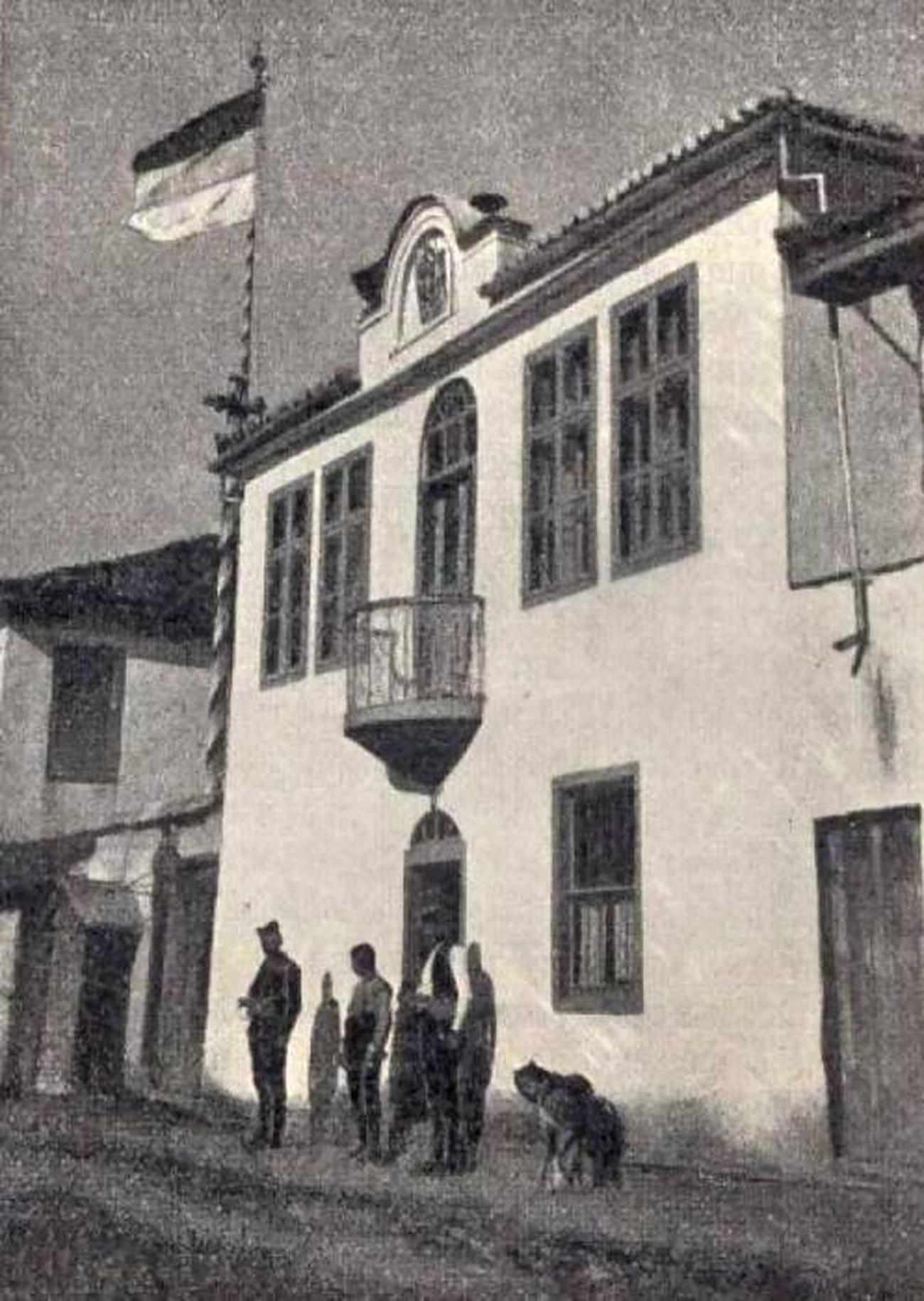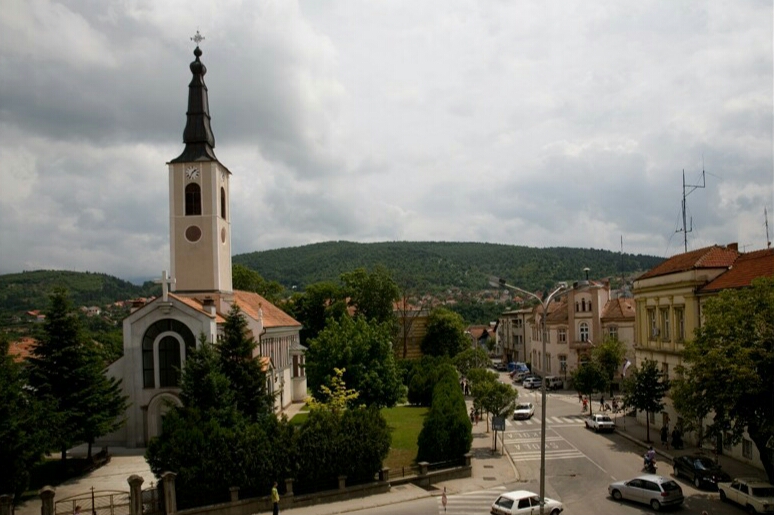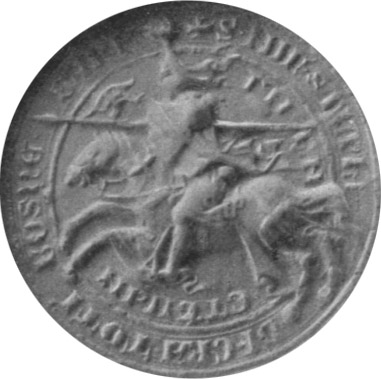Nedeljko F. Radosavljević
Institute of History, Belgrade
ABSTRACT
The paper identifies and describes a legend about Vlatko Vuković, a duke of the Kingdom of Bosnia, and his army taking Communion on their way to the field of Kosovo in 1389. The legend is preserved in Užička Crna Gora, a region in West Serbia which is located north-east of the town of Užice. The relationship between this legend and certain archaeological locations which have still not been completely researched is explained. In addition to (his, we analyse the fact that, regardless of legend’s historical underpinnings, it was recorded in an area through which Vlatko Vuković’s army probably did not pass on its way to Kosovo Polje in 1389.
Key words: Vlatko Vuković, Kosovo Polje, Užička Crna Gora, Communion, legend.
* * *
In Užička Cma Gora (a region in westem Serbia north of the town of Užice, near the slopes of the mountains Povlen, Maljen and Jelova Gora)1 there is a legend saying that Vlatko Vuković took Communion with his army in a local church on his way to Kosovo 1389 (Radosavljević 1997:76, Mihaljčić 2006: 267).2 This short legend contains no other elements.3
Geographically it is associated with several archaeological sites situated near Kosjerić4 (Kuzmanska stjena, Zlostup, Dusko polje, Paramun, cic) where the local people believe that here had once been churches. Most of these locations have only been identified as such by archaeologists, so it is not even possible to claim with certainty whether these Were sacral buildings, i.e. churches, or whether they were of some other type that could not have been used for such purposes.5
The legend about the army of Vlatko Vuković is not limited to the region of Užička Cma Gora. It is also found in a wider area including the entire Užice region, as well as in othcr locations in western Serbia, which were at the time not ruled by Vlatko Vuković, but by Lazar Hrebljanović.6
After the death of Tsar Uroš, the last Serbian ruler from the Nemanjić dynasty, in 1371, Prince Lazar, who led the army 10 Kosovo, managed to unite the regions of the former Serbian state, and then consolidate them in terms of their economic and military potential. By 1373, he had managed to break the resistance of the local lord of Užice, Nikola Altomanović, and to conquer the region. He was killed on Vidovdan, 15 June 1389, in a battle against the Ottoman army (Mihaljčić 2011; 472-474), so one would expect ihe legends about Lazar’s army taking Communion to be more present in these places, rather than legends about Vlatko Vuković. This, however, is not the case.
At a first glance, it is perplexing that there is no mention of the Serbian armies in the oral tradition of the people in Užička Crna Gora traveling from Užice to Kosovo, which certainly must have happened, as all military resources of the Serbian state had been mobilised in this clash. On the contrary, the legends from this area speak only about Vlaiko Vuković, who also took part in the Battle of Kosovo.
The duke Vlatko Vuković was one of the most respected people in the Kingdom of Bosnia. The army he led to Kosovo at the time represented the entire Bosnian state. The legend, however, does not speak of Bosnian army, but about the army of Vlatko Vuković, which makes identification of possible historical strongholds more complex. The veracity of this oral tradition cannot be confirmed by historical geography either. Neither the main nor the shortest road leading to Kosovo Polje passed through Užička Crna Gora,7 hence again the question of how Vlatko Vuković entered the legends in Užička Crna Gora.
As mentioned previously, Duke Vlatko Vuković took part in the Battle of Kosovo and also survived it (Mihaljčić 1989:116). Upon his return from Kosovo Polje, the duke continued to rule over the lands that his successors of the Kosača dynasty later named Herzegovina,8 whereas the other Serbian states fell under Ottoman rule soon alter the battle.9
In the search for the historical basis of this legend and its presence in Užička Crna Gora,
several historical facts must first be taken into account:
- Vlatko Vuković was a historical character who took part in the Battle of Kosovo in
1389. - A legend about him exists and is well preserved in the oral tradition of the inhabitants of Užička Cma Gora. Topographically, it is related to several specific locales.
- These locations have not been explored; nevertheless, according to the oral tradition, they are sites of one time churches and monasteries, which may or may not be correct.
- Judging by the routes that were not significantly altered in the period afterwards, the army of Vlatko Vuković in all likelihood could not have passed through Užička Crna Gora.
The legend about Vlatko Vuković, which is preserved in Užička Crna Gora seems to be firmly rooted. lt does not contain any signs of uncertainty regarding his identity or the direction he took with his army. In addition to this, the memory of this man, preserved in the oral tradition of Užička Crna Gora, has not become embellished over time by features like the disproportional glorification of his importance or heroic acts he performed, as was he case, for example, with Marko Kraljević. Also, his name does not vary, which would indicate that fictionalisation has occurred only to a certain extent. Furthermore, the central motif of the legend, taking Communion before the battle but on the way to the battlefield, was something expected among Orthodox Christians. In addition to this, the figure of Vlatko Vuković has been preserved only in Serbian oral tradition and not in that of others. More precisely, it is present in one specific Serbian region where legends about him are very widespread, although Užice and its surroundings belonged to Duke Lazar Hrebljanović at the time, and not to the Kingdom of Bosnia.
Legends about the duke Vlatko Vuković are also very much alive in the areas that had once been under his rule within the historical boundaries of Herzegovina which now encompasses several modern-day states (Serbia, Montenegro and Bosnia and Herzegovina). What is more, this region is ethnically homogenous, but not religiously.
The origin of this legend should therefore be associated with Herzegovina, the homeland of Vlatko Vuković, where the participation of his army in the enormous battle against the Ottoman Empire on Kosovo Polje has been engraved in the memories of his and his successors’ subjects. Regardless of the disappearance of Medieval Christian nobility, the legend continued to live on in the oral chronicles of ordinary people.10 Although this does not fully answer the question regarding the origin of the legend in Užička Crna Gora. This is an important fact which might lead to the answer. Research into the past of Užice and its surroundings in the period afterward provides a clarifying approach that might explain the existence of this legend in the context of the demographic migrations of the people over space and time.
During the Great Turkish War (1683—1699), the military operations of the Habsburg Monarchy spread to Serbian soil as well. The Habsburg army repossessed Užice from the Ottoman army in 1688, and a depopulation trend soon weakened this area. The local inhabitants, whose mentality was similar to that of the inhabitants of Kosovo and Metohija, began to migrate to the western parts of Slavonia. After the Ottoman counterattack undertaken in 1690 the west of Serbia became almost entirely deserted, due to the Great Serb Migration (Bojanić, 1989: 212—226). After the Second Serb Migration that occurred during the Austro-Turkish War of 1737-1739, this depopulation trend was completed (Radosavljević, 2000: 25), and this region became almost completely uninhabited.
The demographic recovery of this area began soon after the Treaty of Belgrade in 1735 and lasted until the early 20th century. Užička Crna Gora, being the region most devoid of old Serbian families, according to Ljubomir Pavlović, one of the most eminent Serbian anthropo-geographers (Pavlović, 1925:32), was gradually repopulated by Serbs from Herzegovina after 1739. These people brought with them not only their possessions, but their material and spiritual culture, and their specific form of family organization (cooperatives). Apart from different elements of their spiritual heritage (ijekavica dialect, proverbs and customs), which is a visible heritage of the people in Užička Crna Gora from their motherland, their oral popular tradition has also been preserved to the present day.11
As the legends about Duke Vlatko Vuković were closer and more important to the population from Herzegovina than legends about other personalities, an because the duke was an important historical figure from their old country who did exactly what he was remembered for (participating in the battle of Kosovo) the content of this oral tradition underlines another significant feature typical for legends originating from the area surrounded by the Dinaric Mountains. They generally do not contain elements that enhance the supernatural power of their principle characters, nor do these individuals oppose an imaginary enemy. Instead, the main characters always struggle against their true invader – the Ottoman Turks.
Upon their arrival to the new region, Užička Crna Gora, the people of Herzegovina found a significant number of archaeological sites, some of which were the actual remains of churches and monasteries. The settlers from Herzegovina, who generally came from the same region as the Kosača family, used these remains which were not a part of their original tradition a a foundation for heir collective memory This might be the main reason that would explain fully the memory on Vlatko Vuković was preserved instead of the memory on another local lord from this area. Furthermore, Vlatko Vuković, who participated in the battle of Kosovo undarmy of Vlatko Vukovićoubtedly took Communion with his army prior to the ominous battle of Kosovo Polje in 1389.
CONCLUSION
Taking all of this into consideration, it can be concluded that legends about localities which are very diverse in terms of their motifs and content sometimes can be based on a real historical event, but also digress from it. Legends about the duke Vlatko Vuković, which have been preserved in the oral chronicles of the people of Užička Crna Gora, are just a case in point. They are related to an actual historical event, in this case, the departure of the Bosnian army under the command of Vlatko Vuković for Kosovo Polje in 1389 in order to help Prince Lazar Hrebeljanović oppose the forces of the Ottoman Sultan Murat I. And even if Duke Vlatko Vuković, in all likelihood, did not pass through Užička Crna Gora on his way to Kosovo Polje, the existence of the legend about him in various localities of this region indicates real migrations and aids in their better understanding. ln this case, they speak about the settlement process of the Užice district brought about by the population from Herzegovina after the Treaty of Belgrade, signed in 1739.
Translated from Serbian into English by Bojana Radovanović.
BIBLIOGRAPHY
Oral narration of Radovan Obrenovič from Seča Reka
Oral narration of Sava Marjanović from Subjel
Bošković, Đorđe (1953). Arheoloski spomenici i nalazišta u Srbijt I, zapadna Srbija. Beograd: Naučna knjiga Beograd.
Bojanić, Dušanka (1989). “Zapadna Srbija u austro-turskom ratu”. In: Danica Milić (ed) Istorija Titovog Užica I. Titovo Užice: Dimitrije Tucović, 212-226.
Mihaljčić, Rade (1989). Lazar Hrebeljanović. Belgrade: BIGZ.
Mihaljčić, Rade (2006). “Vlatko Vuković.” Srpski biografski rečnik Matice srpske 2, Novi Sad: Budućnost, 267.
Mihaljčić, Rade (2011). “Lazar Hrebeljanović”. Srpski biografski rečnik Matice srpske 5. Novi Sad: Budućnost: 472-474.
Pavlović, Ljubomir (1925). “Užička Cma Gora”, Naselja i poreklo stanovništva 19. Beograd: SKA.
Radosavljević, Nedeljko (1997). “Usmena hronika Seče Reke i istorijska realnost, prilog proučavanju naseljavanja Užičke Cme Gore“. Godišnjak za društvenu istoriju IV/I: 15-85.
Radosaljević, Nedeljko (2000). Užičko — valjevska mitropolija 1739-1804. Valjevo – Mekić.
Ćirković, Sima (2006), “Vlatko Vlađević”. Srpski biografski rečnik Matice srpske 2. Novi Sad: Budućnost, 267.
ГДЕ ЈЕ ВЛАТКО ВУКОВИЋ ПРИЧЕСТИО ВОЈСКУ
(ИСТОРИЈСКИ КОРЕНИ ЈЕДНОГ ПРЕДАЊА)
ЗАКЉУЧЦИ
У Ужичкој Црној Гори, области северно од града Ужица према Повлену, Маљену и Јеловој Гори, сачувано је предање о томе да је, на путу ка Косову пољу 1389, војвода Босанског краљевства Влатко Вуковић причестио војску. Предање је везано за тачно убициране археолошке локалитете. У њему нема садржаја који главном актеру, војводи Вуковићу, дају натприродну снагу, док је његово учешће у Косовском боју историјска чињеница. Осим. тога, непријатељ са којим се он бори је стварпи, тада актуелни освајач, војска Османског царства. Предање је кратко, и није распрострањено на целокупном српском етничком простору, већ само на једном његовом делу. Код локалног становништва, међутим, нису сачувана слична предања која се односе на локалну војску из Ужица или и њене старешине, који су такође узели учешће у Косовском боју. Објашњење за то налази се у чињеници да је, након периода ратова Османског царства и Хабзбуршке монархије и њених савезника (1683–1699), простор западне Србије демографски испражњен сеобама, а након тога насељен херцеговачким српскмим елементом, највише из области коју је, све до 1482. контролисала породица Косача, којој је припадао и Влатко Вуковић.
Зато се сматра да су нови досељеници на затечене археолошке локалитете надоградили своју усмену традицију.
This paper originated as a result of research undertaken as part of a project of the Ministry of Science and Education of the Republic of Serbia, entitled Европа и Срби 1804-1918, подстицаји и искушења европске Модерне (Ев. бр. 177031), (Europe and the Serbs 1804-1918, stimuli and trials of the European Moderna, file number 177031), under the leadership of Slavenko Terzić, Senior Research Fellow, undertake at the Institute of History in Belgrade.
- Crna Gora was one of the two duchies of the nahi of Užice under the Ottoman rule, and after 1830 was a district in the county of Užice. This region is not geographically related to the state of Montenegro. It should be emphasised that several Serbian regions bore that name under Ottoman rule. In this particular case, it is believe that this apellation was given to this region due to the dark aspect of the northern slopes of Crnokosa Mountain, which is covered with dense beech forests. ↩︎
- Vlatko Vuković ( ? – 1392), duke of the Kingdom of Bosnia, founder of the Kosača noble family. The core of the region controlled by the Kosača family lay in the Upper Drina valley. He was mentioned as a duke for the first time in 1378. In August 1388, Duke Vlatko Vlahović defeated a powerful Ottoman detachment near Bileća. Afterwards, in 1389, he lead a detachment sent by the Bosnian king Tvrtko I Kotromanić to Kosovo to help Prince Lazar Hrebeljanović struggle against the Ottoman army of the Sultan Murat I. After the battle of Kosovo, Vuković retreated with the remaining Bosnian army. He died in 1392 of old wounds. In accounts contemporary to the battle of Kosovo, as well as in later ones, Duke Vlatko Vlahović is in several places regarded as identical to a duke Vlatko Vlađević who held lands in Vlađevina (present-day Lađevina) in the surroundings of Rogatica. This identification has, however, been rejected as false, because the names of both Vlatko Vuković and Vlatko Vlađević appear in one particular document (Ćirković 2006:267). In addition to this, the year of Vlatko Vlađević’s death (1407) does not correspond with the year of Vlatko Vuković’s death. ↩︎
- Some informants who told this legend to the author are still alive, such as Radovan Obrenović from Seča Reka and Sava Marjanović from Subjelo (Radosavljević 1997, 78-79). ↩︎
- A town situated in western Serbia, in the center of Užička Crna Gora. ↩︎
- Numerous archaeological sites were identified in the 1950’s. It is also possible that there are several archeological layers in these locations (Bošković 1953: passim). ↩︎
- The author heard these same legends related to some localities on Mt. Zlatibor and in Old Herzegovina. ↩︎
- This particular road passed through the medieval district of Dabar and the region of Raška. ↩︎
- One of his successors, Stjepan Vukčić Kosača, obzained the title herceg of St. Sava in 1448, which gave a new appellation to the lands subject to his rule. The monastery of Mileševa where the relics of St. Sava were originally interred was situated in one of these. ↩︎
- The consequences of this battle, however, were farreaching for all medieval Serbian states – they lost their independence. the gall of the Serbian Despotate under the Osmanic rule (1459) was followed by the greatest part of Bosnia (1461) and well as Herzegovina, which fell under Ottoman domination in 1482. ↩︎
- In the area of Bileća municipality, there is the church of St. Archangel Michael (in Trnovo Dol near Meka Gruda), which is believed to be one of the oldest in Herzegovina. The legend states that this is where duke Vlatko Vuković, on this way to the battle with the Turks, took Communion with his army in 1388 (http://arhiva.eparhija-zahumskohercegovacka.com/node/1424, http://telefonski-imenik.com/bileca/index.htm) ↩︎
- Cf. Radosavljević 1997. ↩︎




